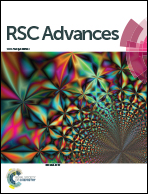Ultrasound accelerated sugar based gel for in situ construction of a Eu3+-based metallogel via energy transfer in a supramolecular scaffold†
Abstract
Two sugar functionalized naphthalimide derivatives (S1, S2) self-assembled into organogels by a heating–cooling process or triggered by ultrasound. The gelation properties in organic solvents were examined by several experiments including UV-vis, fluorescence, FT-IR spectra and SEM, XRD techniques. It was deduced that minor changes in the terminal group had great impact on the gelation and ultrasound responsive properties. Moreover, ultrasound triggered the formation of a yellow emissive gel (S1, with lifetimes in the range of ns) that was readily doped with Eu3+ in situ affording luminescent gels with red emission color (with lifetimes in the range of μs), which expressed efficient energy transfer from the S1 assembly to Eu3+ ion. It was presented that the efficient energy transfer only happened in the ordered fibrous aggregates of S1, whereas, the ET process was not observed in the solution state, indicating the phase control on the ET process. Such findings would pave a new way for the construction of novel rare earth based luminescent materials.


 Please wait while we load your content...
Please wait while we load your content...